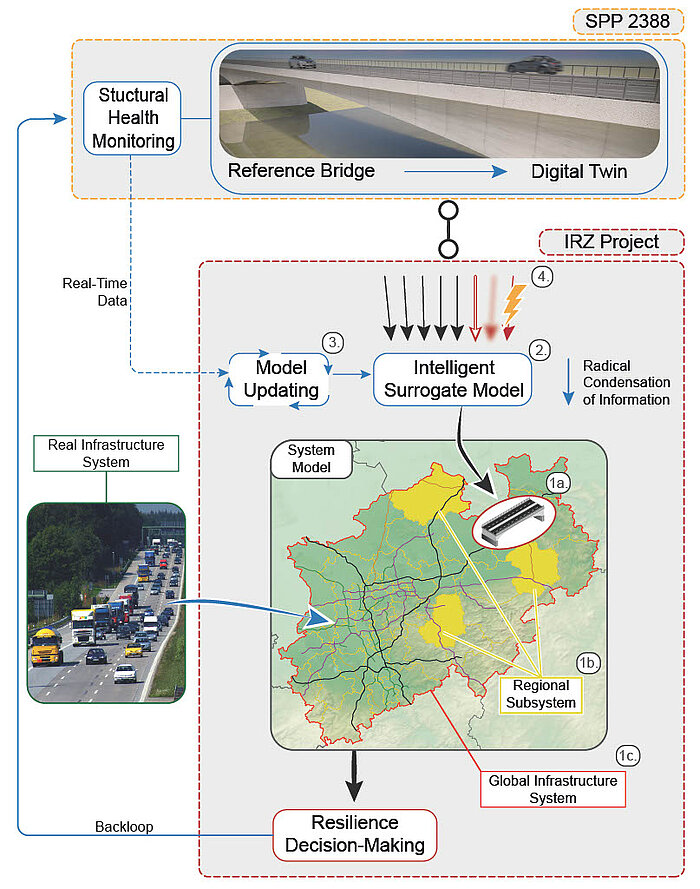Intelligent resilience analysis for infrastructure considering uncertain real-time data
Comprehensive yet efficient numerical modeling and analysis tools for large and complex infrastructure systems are becoming increasingly important for modern societies. In the current project, according developments are integrated into a comprehensive infrastructure resilience framework taking into account cost and uncertainty of various resilience enhancing decision paths. According to Fig. 1, the resilience is quantified based on the time-dependent system performance Q(t) in the presence of disruptive events and degrading effects over the full life cycle. The “resilience triangle” in a single period is characterized by (A) the reliability, (B) the robustness, and (C) the recoverability of the system, as illustrated in Fig. 1, and corresponding improvement measures.
The multidimensional optimization of resilience enhancing decision paths enables cost-effective decision-making for stakeholders in terms of risk prevention as well as maintenance, repair, and overhaul planning. Thereby, the framework allows the crucial consideration of systemic interactions. Key challenges for a realistic analysis include interconnecting numerous models and performance measures at all system levels, analyzing the massive data sets available for critical structures or generated from Structural Health Monitoring (SHM), and accounting for the inherent uncertainty in all available data.
As illustrated in Fig. 2, several system levels are identified at different scales - (1a.) critical technical structures form basic system components, (1b.) regional subsystems represent spatial and functional connectivity, (1c.) all sub-models are aggregated at the global infrastructure system level. This sub-structuring approach not only facilitates the handling of the resulting computational complexity for large infrastructure systems, but also enables precise localization of critical regions and components. At the component level, (2.) an intelligent surrogate modeling procedure based on automated machine learning is developed to condense the vast amount of data available for the SPP 2388 reference bridge into a probabilistic, time- & state-continuous surrogate model. A corresponding (3.) model updating procedure fits the real-time data collected by SHM to the surrogate model to ensure accurate predictions.Uncertainties arising from (4.) conflicting, vague, or incorrect (real-time) data will be quantified and propagated through the systemic model. At the regional subsystem level, critical infrastructure components are linked and integrated into a newly developed system reliability model that enables comprehensive yet efficient numerical analyses. Further reduction of the complexity of subsystem models is achieved by clustering similar components into component types.
Information resulting from subsystem reliability modeling is integrated into the developed life cycle resilience decision-making framework, including recovery models and cost functions.
This overall framework will enable decision-makers to make cost-efficient life cycle decisions in maintenance, overhaul and repair planning as well as design processes, considering component lifetimes and monetary constraints. The developed approaches on component level are demonstrated for the reference bridge "Nibelungenbrücke Worms" (Bundesstraße 47). On the system level, the surrounding infrastructure system is considered, whereby the counties are divided into regional subsystems and physical properties of further critical structural components are assumed for demonstration purposes.
Contact
Publications
Peer-Reviewed Journal Paper
Salomon, J., Behrensdorf, J., Winnewisser, N., Broggi, M., & Beer, M. (2022). Multidimensional Resilience Decision-Making for Complex and Sub-Structured Systems. Resilient Cities and Structures, 1(3), 61-78.
Winnewisser, N. R., Salomon, J., Broggi, M., & Beer, M. (2023). The Concept of Diagonal Approximated Signature: New Surrogate Modeling Approach for Continuous-State Systems in the Context of Resilience Optimization. Disaster Prevention and Resilience, 2(2), N-A.
Still in Progress:
A journal paper based on conference papers [6],[9], and [11] is in progress (planned submission in Q3 2025)
A journal paper within Cluster D is in progress (planned submission in Q3-4 2025)
A journal paper based on conference papers [1], [2], and [10] as well as journal paper [1] and [2] is in progress (planned submission in Q4 2025)
Konferenz und andere VÖ
Winnewisser, N. R., Salomon, J., Broggi, M., & Beer, M. (2023) The Concept of Diagonal Approximated Signature: New Surrogate Modeling Approach for Continuous-State Systems. In ASCE Inspire 2023 (pp. 258-266).
Winnewisser, N. R., Salomon, J., Shi, Y., Broggi, M., & Beer, M. (2024) Generalizing the Diagonal Approximated Signature to Systems With Multiple Component Types. Advances in Reliability, Safety and Security, Part 2, ESREL2024.
Winnewisser, N., Beer, M., Kosheleva, O., & Kreinovich, V. (2024). Somewhat Surprisingly,(Subjective) Fuzzy Technique Can Help to Better Combine Measurement Results and Expert Estimates into a Model with Guaranteed Accuracy: Digital Twins and Beyond. NAFIPS 2024.
Winnewisser, N. R.; Kreinovich, V.; and Kosheleva, O. (2024). "From Quantifying and Propagating Uncertainty to Quantifying and Propagating Both Uncertainty and Reliability: Practice-Motivated Approach to Measurement Planning and Data Processing". Departmental Technical Reports (CS). 1861.
Winnewisser, N., Mett, F., Beer, M., Kosheleva, O., & Kreinovich, V. (2024). Using Known Relation Between Quantities to Make Measurements More Accurate and More Reliable. XXIV IMEKO World Congress 2024.
Winnewisser, N. R., Potthast, T., Mett, F., Perin, A., Broggi, M., & Beer, M. (2024) How to Be Certain: Using Known Relations and Trust Discount to Determine Confidence About the Degree of Uncertainty. EWSHM2024.
Winnewisser, N., Beer, M. Kosheleva, O. & Kreinovich, V. (2025, March) How Shapley Value and Its Generalizations Can Help in the Analysis of Complex Engineering Systems and What Next. In International Symposium on Integrated Uncertainty in Knowledge Modelling and Decision Making (pp. 85-97). Springer Nature Singapore
Winnewisser, N., Beer, M. Kosheleva, O. & Kreinovich, V. (2025, March) What is Optimal Granularity When Estimating Reliability of a Complex Engineering System. In International Symposium on Integrated Uncertainty in Knowledge Modelling and Decision Making (pp. 85-97). Springer Nature Singapore
Winnewisser, N. R., Hoyer, M., Bartels, J. H., Mett, F., Potthast, T., Marx, S. & Beer, M. (2025, May) How to Determine the Level of Epistemic Uncertainty and Exclude Faulty Sensors in Structural Health Monitoring Systems. (accepted) At Symposium 2025 in Tokyo of the International Association for Bridge and Structural Engineering
Marsili F., Winnewisser N.R., Beer M., & Kessler S. (2025, June) Continuous-state survival functions for reinforced concrete bridges based on physics-based degradation models and visual inspection, (accepted) ESREL 2025
Hoyer, M., Winnewisser, N. R., Bartels, J. H., F., Potthast, T. & Beer, M. (2025, September) Investigation of Robustness in Detectiing and Localizing Sensor Malfunctions in Deteriorating Structural Health Monitoring Systems (submitted) IWSHM 2025
Möller, S., Potthast, T., Winnewisser, N., Jonscher, C., Beer, M. & Rolfes, R. Quantifying the Required Sample Size for Desired Confidence in Damage Detection of Structural Health Monitoring (submitted) IWSHM 2025







